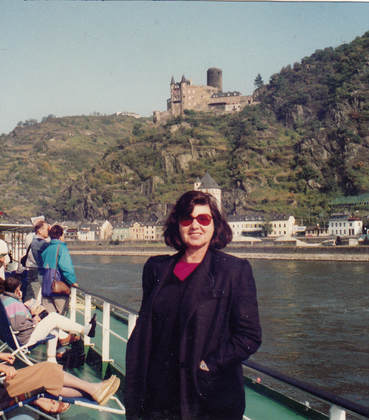 Sherrill on the Rhine
Sherrill on the Rhine On an autumn morning in 1992, we landed in Zurich, Switzerland. Back then, the city still retained some of its old world charm and was easy to explore on foot. In a medieval square, we even encountered students trying to raise cash as street musicians and mimes.
"Where are you from?" Sherrill asked a motley dressed young man.
"California," he replied. "Berkeley."
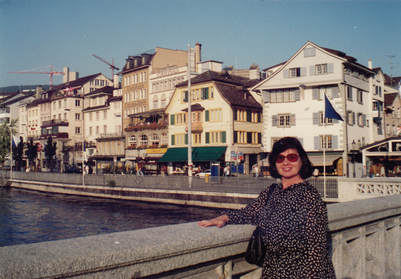 Sherrill in Zurich, Switzerland
Sherrill in Zurich, Switzerland "How can you sleep?" Sherrill demanded in the middle of the night, shaking me as it began its journey north on the Rhine. "We're moving!"
"I know."
But I joined her at our cabin window, gazing out at the moon's reflection on the dark water and the lights dotting the shore.
The first stop, the next day, was the medieval city of Strasbourg in French Alsace. Not in Germany, yet, but on the border. We took far too many photographs (this was in the days of film), but couldn't resist snapping when confronted with the weathered red sandstone cathedral, the medieval bridge with four great towers, and the half-timbered houses of the old city center.
"I suppose you're going to climb that." Sherrill asked, when she saw me gazing up at the cathedral tower. "Here, you'd better take this. You'll want proof that you did it."
I took the camera and snapped some shots when I went up, but the photos of the rooftops weren't too exciting.
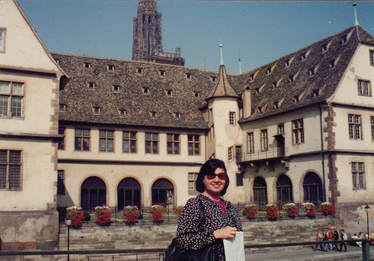 Sherrill in Strasbourg, Germany
Sherrill in Strasbourg, Germany Sherrill and I never could resist the picturesque and romantic, so the next section of the Rhine easily excited our imaginations: castles on all sides, dramatic cliffs, vineyards bright with autumn colors, and villages studded with gothic and Romanesque churches. The river was surprisingly busy along there, with barges, ferries, yachts, and occasional cruise ships. We passed the notorious Lorelei rock, more than 400 feet high, from which—according to legend and poetry—a lovely maiden sang her siren song to lure sailors to their deaths. Whether not the tale was true, the scene was beautiful and dramatic enough to believe its attraction.
"Of course," Sherrill commented, "all those boats sank because of a wicked female, not poor navigation!"
During her research, Sherrill had managed to discover a restaurant in one of the few authentic medieval buildings left in Cologne's old town next to the Rhine—a perfect place to celebrate our 28th wedding anniversary. I remember that it had a pricy wine list and a lot of rich desserts and that Sherrill indulged in the house specialty, grilled pig knuckles, but I don't recall what I had for my main dinner. Whatever it was, I'm sure it was less interesting.
Sherrill had figured out how we could squeeze in a day trip to Mainz so that we could visit the Gutenberg Museum. The city also was bombed during the War, but part of the old town survived, including the Romanesque cathedral and enough of the renaissance building that housed the Gutenberg museum so that it could be restored and its historical artifacts returned, including some of the first movable type printing presses and two Gutenberg Bibles. Words and books have always been at the center of my life, but I was surprised by how emotional I felt gazing at those primitive printing presses.
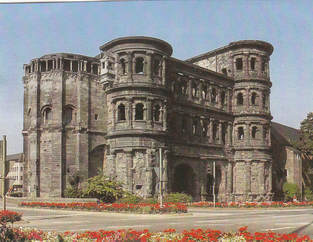 "Porta Nigra," Roman Gate, Trier, Germany
"Porta Nigra," Roman Gate, Trier, Germany Our timing also was lucky, because in addition to ancient Rome we hit Trier during the Federweisserfest. Tables were set out with bottles of Federweisser, a young white wine sold only in September and October, called "white feather" wine because it's still fermenting and a bubbly white color. We liked it, so we bought a bottle to take back to the hotel. We also liked the onion "cake" always sold with it, really an onion tart, and bought a couple to join the fedderweisser. The wine seemed very light, but by the time we fell into bed, we might have been in ancient Rome.
Maybe it was the wine from the evening before, but in the morning we made a point of visiting the house in Trier where Karl Marx was born. A typical early 18th century middle-class home, it wasn't particularly distinguished, but it had been turned into a combination museum, library, and research center for Marx and Engels studies. My radical youth never would have forgiven me if I'd missed it.
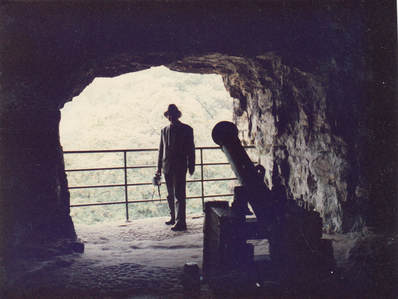 Bruce in Luxembourg City Fortifications
Bruce in Luxembourg City Fortifications I don't remember exactly how far Trier was from Luxembourg City, but less than an hour by train got us up there. And by the time we stepped off that train, we'd also got a good idea why the place was called the "Gibraltar of the North."
To start with, the city was perched on steep, massively fortified cliffs that dropped to deep, narrow valleys and gorges. From the original medieval castle, the city walls and network of underground fortifications and defenses had grown into the stupendous result that we saw. During WW II, they were used as bomb shelters for 35,000 people. Although the country was officially neutral, the Nazis quickly occupied it and declared it part of Germany. Walking through the gloomy hollowed out fortifications under the capital city was a strange experience.
A favorite memory from this trip is of when Sherrill and I were walking together through those underground casements that had been dug centuries before into the steep sides of the cliffs beneath what became Luxembourg City.
"Just think," I said, "what it would have been like down here while the city up there was being bombarded, all this shaking around us, dirt falling, feeling that we might be buried alive any moment."
"Too much imagination, sweetie," she said, taking my chin between her fingers and giving me a little kiss.
All that hiking and climbing had given us appetites and after days of heavy German food, we were ready for something different. Margaritas and chips with salsa were only the beginning. Then, eventually, we descended back to Trier and a day later traveled by boat to Bernkastel on the Moselle river.
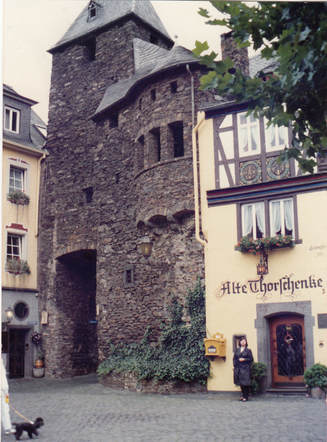 Sherrill, Bernkastel, Germany
Sherrill, Bernkastel, Germany The next day, we made it to the town of Cochem on the Moselle, but not by boat—with a combination of taxi and train. This time, the room we found was in a 300 year-old inn huddled next to a Medieval city gate. We weren't sure what we'd be doing day-to-day, now, or even hour-to-hour, but were enjoying ourselves and seeing a lot. And were drinking more of the federweisser wine and other wines, as well—after all, we could see the vineyards rising in terraces up to a hilltop castle, so we might as well get to know the local product. The many bends and twists in the Moselle of this area made it resemble a piece of yarn a cat had been playing with. Sometimes, it came very close to doubling back on itself.
The large, ornate castle on the peak above the town was an obvious fake, a nineteen century fantasy that in the 19th century had replaced an authentic ruin. It belonged as a backdrop in a Ruritanian operetta, but we rather liked it, just as we were amused by the amateur oompah-pah band that we watched stumble past the half-timbered buildings.
To be continued....
 RSS Feed
RSS Feed